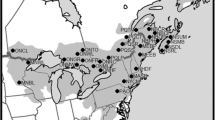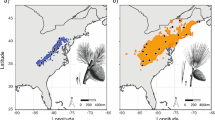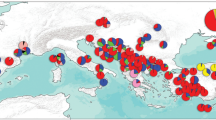Abstract
Fragmentation acting over geological times confers wide, biogeographical scale and genetic diversity patterns to species, through demographic and natural selection processes. To test the effects of historical fragmentation on the genetic diversity and differentiation of a widespread forest tree, Pinus nigra Arnold, the European black pine, and to resolve its demographic history, we described and modelled its spatial genetic structure and gene genealogy. We then tested which Pleistocene event, whether recent or ancient, could explain its widespread but patchy geographic distribution. We used a set of different genetic markers, both neutral and potentially adaptive, and either bi-parentally or paternally only inherited, and we sampled natural populations across the entire species range. We analysed the data using both frequentist population genetic and Bayesian inference methods to calibrate realistic, demographic timed scenarios. We also considered how habitat suitability might have affected demography by correlating climate variables at different recent Pleistocene ages with genetic diversity estimates. Species with geographically fragmented distribution areas are expected to display significant among-population genetic differentiation and low within-population genetic diversity. Contrary to these expectations, we show that the current diversity of Pinus nigra and its weak genetic spatial structure result from the Late Pleistocene or Early Holocene fragmentation of one ancestral population into six distinct genetic lineages. Gene flow among the different lineages is strong across forests and many current populations are admixed between lineages. We propose to modify the currently accepted international nomenclature made of five sub-species and name these six lineages using regionally accepted sub-species-level names.




Similar content being viewed by others
References
Andrén H (1994) Effects of habitat fragmentation on birds and mammals in landscapes with different proportions of suitable habitat: a review. Oikos 71:355–366. https://doi.org/10.2307/3545823
Austerlitz F, Mariette S, Machon N, Gouyon PH, Godelle B (2000) Effects of colonization processes on genetic diversity: differences between annual plants and tree species. Genetics 154:1309–1321
Barbéro M, Loisel R, Quézel P, Richardson DM, Romane F (1998) Pines of the Mediterranean Basin. In: Richardson DM (ed) Ecology and biogeography of Pinus. Cambridge University Press, Cambridge, pp 153–170
Barthe S, Binelli G, Hérault B, Scotti-Saintagne C, Sabatier D, Scotti I (2017) Tropical rainforests that persisted: inferences from the Quaternary demographic history of eight tree species in the Guiana shield. Mol Ecol 26:1161–1174. https://doi.org/10.1111/mec.13949
Beerli P, Palczewski M (2010) Unified framework to evaluate panmixia and migration direction among multiple sampling locations. Genetics 185(1):313–326
Conord C, Gurevitch J, Fady B (2012) Large-scale longitudinal gradients of genetic diversity: a meta-analysis across six phyla in the Mediterranean basin. Ecol Evol 2:2600–2614. https://doi.org/10.1002/ece3.350
Cornuet JM, Pudlo P, Veyssier J, Dehne-Garcia A, Gautier M, Leblois R, Marin J-M, Estoup A (2014) DIYABC v2.0: a software to make approximate Bayesian computation inferences about population history using single nucleotide polymorphism, DNA sequence and microsatellite data. Bioinformatics 30:1187–1189. https://doi.org/10.1093/bioinformatics/btt763
Dąbrowski MJ, Pilot M, Kruczyk M, Żmihorski M, Umer HM, Gliwicz J (2014) Reliability assessment of null allele detection: inconsistencies between and within different methods. Mol Ecol Resour 14:361–373. https://doi.org/10.1111/1755-0998.12177
Debazac EF (1964) Le pin laricio de Corse dans son aire naturelle. Revue Forestière Française 3:188–215
Earl DA, vonHoldt BM (2012) STRUCTURE HARVESTER: a website and program for visualizing STRUCTURE output and implementing the Evanno method. Conserv Genet Resour 4:359–361. https://doi.org/10.1007/s12686-011-9548-7
Eckert AJ, Hall BD (2006) Phylogeny, historical biogeography, and patterns of diversification for Pinus (Pinaceae): phylogenetic tests of fossil-based hypotheses. Mol Phylogenet Evol 40(1):166–182. https://doi.org/10.1016/j.ympev.2006.03.009
Eliades NGH, Gailing O, Leinemann L, Fady B, Finkeldey R (2011) High genetic diversity and significant population structure in Cedrus brevifolia Henry, a narrow endemic Mediterranean tree from Cyprus. Plant Syst Evol 294:185–198. https://doi.org/10.1007/s00606-011-0453-z
Evanno G, Regnaut S, Goudet J (2005) Detecting the number of clusters of individuals using the software STRUCTURE: a simulation study. Mol Ecol 14:2611–2620. https://doi.org/10.1111/j.1365-294X.2005.02553.x
Excoffier L, Lischer HE (2010) Arlequin suite ver 3.5: a new series of programs to perform population genetics analyses under Linux and Windows. Mol Ecol Resour 10:564–567. https://doi.org/10.1111/j.1755-0998.2010.02847.x
Fady B, Conord C (2010) Macroecological patterns of species and genetic diversity in vascular plants of the Mediterranean basin. Divers Distrib 16:53–64. https://doi.org/10.1111/j.1472-4642.2009.00621.x
Falush D, Stephens M, Pritchard JK (2003) Inference of population structure using multilocus genotype data: linked loci and correlated allele frequencies. Genetics 164:1567–1587
Farjon A (2010) A handbook of the world’s conifers. Koninklijke Brill, Leiden
Feurdean A, Tămaş T, Tanţău I, Fărcaş S (2012) Elevational variation in regional vegetation responses to Late-Glacial climate changes in the Carpathians. J Biogeogr 39:258–271. https://doi.org/10.1111/j.1365-2699.2011.02605.x
Fukarek P (1958) Prilog poznavanju crnoga bora (Pinus nigra Arn.) / A contribution to the knowledge of black pine (Pinus nigra Arn.) / . Rad Poljopr – Šumarsk Fak Univ u Sarajevu 3:3–92
Futuyma DJ (2010) Evolutionary constraint and ecological consequences. Evolution 64:1865–1884. https://doi.org/10.1111/j.1558-5646.2010.00960.x
García-Amorena I, Rubiales JM, Amat EM, Iglesias González R, Gómez-Manzaneque F (2011) New macrofossil evidence of Pinus nigra Arnold on the Northern Iberian Meseta during the Holocene. Rev Palaeobot Palynol 163:281–288. https://doi.org/10.1016/j.revpalbo.2010.10.010
Gaussen H (1949) L’influence du passé dans la repartition des Gymnospermes de la Péninsule Iberique. CR Congr Intern Geogra Lisbonne 2:805–825
Gaussen H, Haywood VH, Chater AO (1964) Pinus. In: Tutin TG (ed) Flora Europaea, vol 1. Cambridge University Press, Cambridge, pp 32–35
Giovannelli G (2017) Histoire évolutive et diversité adaptative du pin noir, Pinus nigra Arn., à l'échelle de son aire de répartition. PhD thesis, Aix-Marseille Université, France
Giovannelli G, Roig A, Spanu I, Vendramin GG, Fady B (2017) A new set of nuclear microsatellites for an ecologically and economically important conifer: the European black pine (Pinus nigra Arn.). Plant Mol Biol Report 35:379–388. https://doi.org/10.1007/s11105-017-1029-z
Goldstein DB, Pollock DD (1997) Launching microsatellites: a review of mutation processes and methods of phylogenetic inference. J Hered 88(5):335–342. https://doi.org/10.1093/oxfordjournals.jhered.a023114
Guichoux E, Garnier-Géré P, Lagache L, Lang T, Boury C, Petit RJ (2013) Outlier loci highlight the direction of introgression in oaks. Mol Ecol 22:450–462. https://doi.org/10.1111/mec.12125
Hardy OJ, Vekemans X (2002) SPAGeDi: a versatile computer program to analyze spatial genetic structure at the individual or population levels. Mol Ecol Notes 2:618–620. https://doi.org/10.1046/j.1471-8286.2002.00305.x
Hardy OJ, Charbonnel N, Fréville H, Heuertz M (2003) Microsatellite allele sizes: a simple test to assess their significance on genetic differentiation. Genetics 163:1467–1482
Hedrick PW (2005) A standardized genetic differentiation measure. Evolution 59:1633–1638. https://doi.org/10.1554/05-076.1
Heuertz M, Teufel J, González-Martínez SC, Soto A, Fady B, Alía R, Vendramin GG (2010) Geography determines genetic relationships between species of mountain pine (Pinus mugo complex) in Western Europe. J Biogeogr 37(3):541–556. https://doi.org/10.1111/j.1365-2699.2009.02223.x
Hewitt GM (1999) Post-glacial re-colonization of European biota. Biol J Linn Soc 68(1–2):87–112. https://doi.org/10.1111/j.1095-8312.1999.tb01160.x
Hijmans RJ, Cameron SE, Parra JL, Jones PG, Jarvis A (2005) Very high resolution interpolated climate surfaces for global land areas. Int J Climatol 25(15):1965–1978
Isajev V, Fady B, Semerci H, Andonovski V (2004) EUFORGEN technical guidelines for genetic conservation and use for European black pine (Pinus nigra). International Plant Genetic Resources Institute, Rome
Jost L (2008) GST and its relatives do not measure differentiation. Ecology 17:4015–4026. https://doi.org/10.1111/j.1365-294X.2008.03887.x
Kalinowski ST, Taper ML (2006) Maximum likelihood estimation of the frequency of null alleles at microsatellite loci. Conserv Genet 7:991–995. https://doi.org/10.1007/s10592-006-9134-9
Kopelman N, Mayzel J, Jakobsson M, Rosenberg NA, Mayrose I (2015) Clumpak: a program for identifying clustering modes and packaging population structure inferences across K. Mol Ecol Resour 15:1179–1191. https://doi.org/10.1111/1755-0998.12387
Kremer A, Ronce O, Robledo-Arnuncio JJ, Guillaume F, Bohrer G, Nathan R, Bridle JR, Gomulkiewicz R, Klein EK, Ritland K, Kuparinen A, Gerber S, Schueler S (2012) Long-distance gene flow and adaptation of forest trees to rapid climate change. Ecol Lett 15:378–392. https://doi.org/10.1111/j.1461-0248.2012.01746.x
Kress WJ, Erickson DL (2007) A two-locus global DNA barcode for land plants: the coding rbcL gene complements the non-coding trnHpsbA spacer region. PLOS ONE 2(6):e508
Librado P, Rozas J (2009) DnaSP v5: a software for comprehensive analysis of DNA polymorphism data. Bioinformatics 25(11):1451–1452. https://doi.org/10.1093/bioinformatics/btp187
Mac Arthur RH, Wilson EO (1967) The theory of island biogeography. Princeton university press
Médail F, Diadema K (2009) Glacial refugia influence plant diversity patterns in the Mediterranean Basin. J Biogeogr 36(7):1333–1345. https://doi.org/10.1111/j.1365-2699.2008.02051.x
Meirmans P, Hedrick P (2011) Assessing population structure: FST and related measures. Mol Ecol Resour 11:5–18. https://doi.org/10.1111/j.1755-0998.2010.02927.x
Mosca E, Eckert AJ, Liechty JD, Wegrzyn JL, La Porta N, Vendramin GG, Neale DB (2012) Contrasting patterns of nucleotide diversity for four conifers of Alpine European forests. Evol Appl 5(7):762–775. https://doi.org/10.1111/j.1752-4571.2012.00256.x
Mossman CA, Waser PM (2001) Effects of habitat fragmentation on population genetic structure in the white-footed mouse (Peromyscus leucopus). Can J Zool 79(2):285–295
Naydenov KD, Naydenov MK, Alexandrov A, Vasilevski K, Gyuleva V, Matevski V, Nikolic B, Goudiaby V, Bogunic F, Paitaridou D, Christou A, Goia I, Carcaillet C, Alcantara AE, Ture C, Gulcu S, Peruzzi L, Kamary S, Bojovic S, Hinkov G, Tsarev A (2016) Ancient split of major genetic lineages of European black pine: evidence from chloroplast DNA. Tree Genet Genomes 12(68):1–18. https://doi.org/10.1007/s11295-016-1022-y
Naydenov KD, Naydenov MK, Alexandrov A, Vasilevski K, Hinkov G, Matevski V, Nikolic B, Goudiaby V, Riegert D, Paitaridou D, Christou A, Goia I, Carcaillet C, Escudero Alcantara A, Ture C, Gulcu S, Gyuleva V, Bojovic S, Peruzzi L, Kamary S, Tsarev A, Bogunic F (2017) Ancient genetic bottleneck and Plio-Pleistocene climatic changes imprinted the phylobiogeography of European black pine populations. Eur J For Res 136:767–786. https://doi.org/10.1007/s10342-017-1069-9
Nei M (1973) Analysis of gene diversity in subdivided populations. Proc Natl Acad Sci U S A 70:3321–3323. https://doi.org/10.1073/pnas.70.12.3321
Nikolić D, Tucić N (1983) Isoenzyme variation within and among populations of European black pine (Pinus nigra Arn.). Silvae Genet 32:3–4
Nyman CF (1879). Conspectus florae Europaeae. Orebro Suecia typis Officinae Bohlinianae
Oosterhout CV, Hutchinson WF, Wills DPM, Shipley P (2004) MICRO-CHECKER: software for identifying and correcting genotyping errors in microsatellite data. Mol Ecol Resour 4:535–538. https://doi.org/10.1111/j.1471-8286.2004.00684.x
Petit RJ, Aguinagalde I, de Beaulieu JL, Bittkau C, Brewer S, Cheddadi R, Ennos R, Fineschi S, Grivet D, Lascoux M, Mohanty A, Müller-Starck G, Demesure-Musch B, Palmé A, Martín JP, Rendell S, Vendramin GG (2003) Glacial refugia: hotspots but not melting pots of genetic diversity. Science 300:1563–1565. https://doi.org/10.1126/science.1083264
Pons O, Petit RJ (1996) Measuring and testing genetic differentiation with ordered vs. unordered alleles. Genetics 144:1237–1245
Postigo-Mijarra JM, Morla C, Barrón E, Morales-Molino C, García S (2010) Patterns of extinction and persistence of Arctotertiary flora in Iberia during the Quaternary. Rev Palaeobot Palynol 162(3):416–426. https://doi.org/10.1016/j.revpalbo.2010.02.015
Pritchard JK, Stephens M, Donnelly P (2000) Inference of population structure using multilocus genotype data. Genetics 155:945–959
Pyhäjärvi T, García-Gil MR, Knürr T, Mikkonen M, Wachowiak W, Savolainen O (2007) Demographic history has influenced nucleotide diversity in European Pinus sylvestris populations. Genetics 177:1713–1724. https://doi.org/10.1534/genetics.107.077099
Rafii ZA, Dodd RS (2007) Chloroplast DNA supports a hypothesis of glacial refugia over postglacial recolonization in disjunct populations of black pine (Pinus nigra) in Western Europe. Mol Ecol 16:723–736. https://doi.org/10.1111/j.1365-294X.2006.03183.x
Raymond M, Rousset F (1995) An exact test for population differentiation. Evolution 49(6):1280–1283. https://doi.org/10.1111/j.1558-5646.1995.tb04456.x
Riginos C, Liggins L (2013) Seascape genetics: populations, individuals, and genes marooned and adrift. Geogr Compass 7:197–216. https://doi.org/10.1111/gec3.12032
Robledo-Arnuncio JJ, Collada C, Alía R, Gill L (2005) Genetic structure of montane isolates of Pinus sylvestris L. in a Mediterranean refugial area. J Biogeogr 32:595–605. https://doi.org/10.1111/j.1365-2699.2004.01196.x
Rodrigo A, Retana J, Pico X (2004) Direct regeneration is not the only response of Mediterranean forests to largest fires. Ecology 85:716–729. https://doi.org/10.1890/02-0492
Roman-Amat B, Arbez M (1986) Pins laricio de Corse et de Calabre, quelles provenances choisir? Revue Forestière Française 37:377–388
Rousset F (2008) GENEPOP’007: a complete re-implementation of the GENEPOP software for Windows and Linux. Mol Ecol Resour 8:103–106. https://doi.org/10.1111/j.1471-8286.2007.01931.x
RStudio Team (2016) RStudio: integrated development for R. RStudio, Inc., Boston URL http://www.rstudio.com/
Rubio-Moraga A, Candel-Perez D, Lucas-Borja ME, Tíscar PA, Viñegla B, Linares JC, Gómez-Gómez L, Ahrazem O (2012) Genetic diversity of Pinus nigra Arn. Populations in Southern Spain and Northern Morocco Revealed By Inter-Simple Sequence Repeat Profiles. Int J Mol Sci 13:5645–5658. https://doi.org/10.3390/ijms13055645
Szpiech ZA, Jakobsson J, Rosenberg NA (2008) ADZE: a rarefaction approach for counting alleles private to combinations of populations. Bioinformatics. https://doi.org/10.1093/bioinformatics/btn478
Takezaki N, Nei M, Tamura K (2014) POPTREEW: web version of POPTREE for constructing population trees from allele frequency data and computing some other quantities. Mol Biol Evol 31(6):1622–1624
Tóth EG, Vendramin GG, Bagnoli F, Cseke K, Höhn M (2017) High genetic diversity and distinct origin of recently fragmented Scots pine (Pinus sylvestris L.) populations along the Carpathians and the Pannonian Basin. Tree Genet Genomes 13:47. https://doi.org/10.1007/s11295-017-1137-9
Vendramin GG, Lelli L, Rossi P, Morgante M (1996) A set of primers for the amplification of 20 chloroplast microsatellites in Pinaceae. Mol Ecol 5:595–598. https://doi.org/10.1046/j.1365-294X.1996.00111.x
Vernet JL (1986) Travertins et végétations holocènes méditerranéennes. Méditerranée 57(1):25–29
Vernet JL, Badal E, Grau E (1983) La végétation néolithique du sud-est de l'Espagne (Valence, Alicante) d'après l'analyse anthracologique. C R Acad Sci Paris 296(III):669–672
Vidaković M (1974) Genetics of European black pine (Pinus nigra Arn.). Ann For 6:57–86
Young A, Boyle T, Brown T (1996) The population genetic consequences of habitat fragmentation for plants. Trends Ecol Evol 11:413–418. https://doi.org/10.1016/0169-5347(96)10045-8
Acknowledgements
We thank O. Gilg, F. Rei, N. Turion and D. Vauthier (INRA UEFM, Avignon, France), J. Rousselet (INRA Orléans, France), S.C. Gonzalez-Martinez (INRA Bordeaux, France), E. Kakouris (Cyprus Forest Department, Nicosia, Cyprus), F. Krouchi (University of Tizi Ouzou, Algeria), G. Huber (Bavarian Office for Forest Seeding and Planting, Teisendorf, Germany), Carmen García-Barriga (National Institute for Agronomy, Madrid, Spain) and H. Sbay (Forest Research Centre, Rabat, Morocco) for the sample collection. Collection of material was made before the Nagoya Protocol on Access to Genetic Resources and the Fair and Equitable Sharing of Benefits Arising from their Utilization to the Convention on Biological Diversity was legally implemented by signatory countries.
Data archiving statement
Raw DNA sequence and genotyping data are to be archived in the Open Access archive Zenodo (https://zenodo.org/).
Funding
This study was made possible by the financial support of the French Forest Service (Office National des Forêts) and the project “Programme global de conservation des populations françaises de pin de Salzmann”. We also acknowledge the support for Sanger DNA sequencing from the French “Bibliothèque du Vivant” project and for SSR genotyping from the French Ministry of Agriculture—Irstea project 2015-339 “Déterminants de la vulnérabilité du pin laricio à la maladie des bandes rouges”. G. Giovannelli was financially supported by Aix-Marseille Université (Ecole Doctorale ED251), France, and the short-term scientific mission programme of the COST Action FP1202, while working on her PhD.
Author information
Authors and Affiliations
Corresponding author
Ethics declarations
Conflict of interest
The authors declare that they have no conflict of interest.
Additional information
Communicated by Z. Kaya
Publisher’s note
Springer Nature remains neutral with regard to jurisdictional claims in published maps and institutional affiliations.
Rights and permissions
About this article
Cite this article
Scotti-Saintagne, C., Giovannelli, G., Scotti, I. et al. Recent, Late Pleistocene fragmentation shaped the phylogeographic structure of the European black pine (Pinus nigra Arnold). Tree Genetics & Genomes 15, 76 (2019). https://doi.org/10.1007/s11295-019-1381-2
Received:
Revised:
Accepted:
Published:
DOI: https://doi.org/10.1007/s11295-019-1381-2




